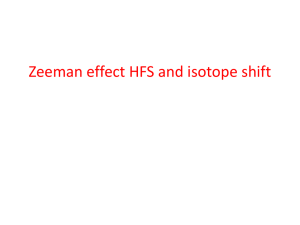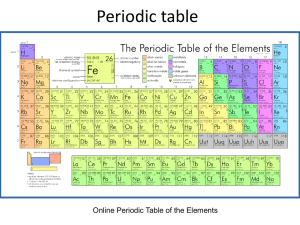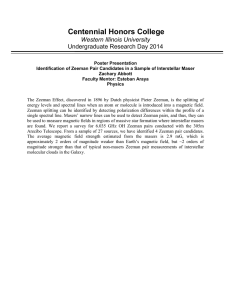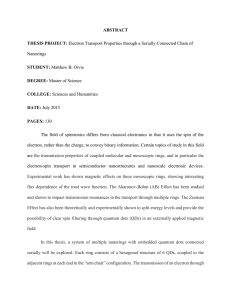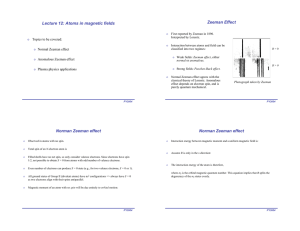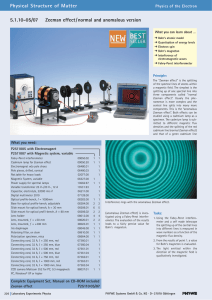o Atoms in magnetic fields: o Normal Zeeman effect o Anomalous
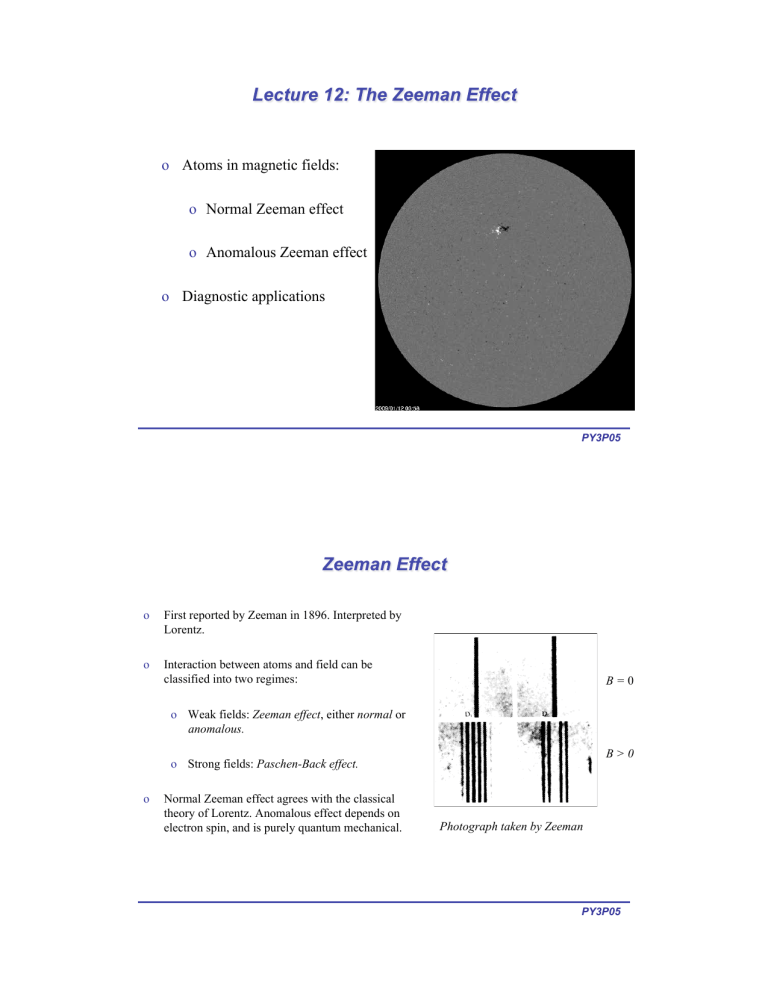
o
Atoms in magnetic fields:
o
Normal Zeeman effect
o
Anomalous Zeeman effect
o
Diagnostic applications
PY3P05 o First reported by Zeeman in 1896. Interpreted by
Lorentz. o Interaction between atoms and field can be classified into two regimes: o Weak fields: Zeeman effect , either normal or anomalous. o Strong fields: Paschen-Back effect. o Normal Zeeman effect agrees with the classical theory of Lorentz. Anomalous effect depends on electron spin, and is purely quantum mechanical. Photograph taken by Zeeman
B = 0
B > 0
PY3P05
o Observed in atoms with no spin. o Total spin of an Nelectron atom is ˆ
=
N
"
s i i = 1 o Filled shells have no net spin, so only consider valence electrons. Since electrons have spin
1/2, not possible to obtain S = 0 from atoms with odd number of valence electrons.
! o Even number of electrons can produce S = 0 state (e.g., for two valence electrons, S = 0 or 1). o All ground states of Group II (divalent atoms) have ns 2 configurations => always have S = 0 as two electrons align with their spins antiparallel. o Magnetic moment of an atom with no spin will be due entirely to orbital motion:
µ = "
µ
B
!
PY3P05
!
o Interaction energy between magnetic moment and a uniform magnetic field is:
" E = # ˆ $ o Assume B is only in the zdirection:
!
ˆ
=
" 0
$
0
$
#
B z
%
'
'
'
& o The interaction energy of the atom is therefore, " E = # µ z
B z
= µ
B
B z m l
where m l is the orbital magnetic quantum number. This equation implies that degeneracy of the m l states evenly.
!
B splits the
PY3P05
o But what transitions occur? Must consider selections rules for m l
: !
m l
= 0, ±1. o Consider transitions between two Zeeman-split atomic levels. Allowed transition frequencies are therefore, h h
" = h "
" = h "
0
0
+
µ
B
B z h " = h "
0
#
µ
B
B z
" m l
" m l
" m l
= # 1
= 0
= + 1 o Emitted photons also have a polarization, depending
on which transition they result from.
PY3P05 o Longitudinal Zeeman effect: Observing along magnetic field, photons must propagate in zdirection. o Light waves are transverse, and so only x and y polarizations are possible. o The zcomponent ( !
m l
= 0) is therefore absent and only observe !
m l
= ± 1. o Termed !
components and are circularly polarized. o Transverse Zeeman effect: When observed at right angles to the field, all three lines are present. o !
m l
= 0 are linearly polarized || to the field. o !
m l
= ± 1 transitions are linearly polarized at right angles to field.
PY3P05
o Last two columns of table below refer to the
polarizations observed in the longitudinal and
transverse directions. o The direction of circular polarization in the
longitudinal observations is defined relative to B. o Interpretation proposed by Lorentz (1896)
( !
m l
" -
= -1 ) ( !
m
" l
= 0 ) ( !
m l
" +
= +1 )
PY3P05 o Discovered by Thomas Preston in Dublin in 1897. o Occurs in atoms with non-zero spin => atoms with odd
number of electrons. o In LScoupling, the spin-orbit interaction couples the spin
and orbital angular momenta to give a total angular
momentum according to
ˆ
=
ˆ
+ o In an applied Bfield, J precesses about B at the Larmor
frequency.
!
o L and S precess more rapidly about J to due to spin-orbit
interaction. Spin-orbit effect therefore stronger.
PY3P05
o Interaction energy of atom is equal to sum of interactions of spin and orbital magnetic moments with Bfield:
" E = # µ z
B z
= # ( µ z orbital + µ z spin ) B z
= L z
+ g s
S z
µ
B
!
B z
where g s
= 2, and the < … > is the expectation value. The normal Zeeman effect is obtained by setting and L z
= m
!
l
!
.
o In the case of precessing atomic magnetic in figure on last slide, neither S
Only ˆ z
= m j
!
is well defined. z nor L z are constant. o Must therefore project L and S onto J and project onto
!
z -axis =>
µ = ˆ " | ˆ | cos #
1
| ˆ |
+ 2 | ˆ | cos #
2
| ˆ |
µ
B
!
!
PY3P05 o The angles #
1
and #
2 can be calculated from the scalar products of the respective vectors:
ˆ
"
ˆ
"
ˆ
= | L || J | cos #
1
ˆ
= | S || J | cos #
2 o
which implies that
Now, using ˆ
=
µ = "
ˆ
#
| ˆ | 2
!
+ 2
ˆ
#
| ˆ | 2
ˆ
"
µ
!
B (1)
ˆ
= J #
ˆ
) " J #
ˆ
) =
ˆ
"
ˆ
+
ˆ
"
ˆ
# L "
therefore
!
so that
!
L
!
"
ˆ
= J "
ˆ
+
ˆ
"
ˆ
#
ˆ
"
ˆ
) /2
!
ˆ
"
| ˆ | 2
=
[ j ( j + 1) + l ( l + 1) # s ( s + 1) ] !
2 j ( j + 1) !
2
/2
=
[ j ( j + 1) + l ( l + 1) # s ( s + 1) ]
2 j ( j + 1) o Similarly,
!
ˆ
"
ˆ
= J "
ˆ
+
ˆ
"
ˆ
#
ˆ
"
ˆ
) /2 and
ˆ
"
| ˆ | 2
=
[ j ( j + 1) + s ( s + 1) # l ( l + 1) ]
2 j ( j + 1)
PY3P05
!
!
o We can therefore write Eqn. 1 as
µ = " ˆ
#
%
$
[ j ( j + 1) + l ( l + 1) " s ( s + 1) ]
2 j ( j + 1)
" 2
[ j ( j + 1) + s ( s + 1) " l ( l + 1) ]
2 j ( j + 1)
&
µ
(
'
!
B o This can be written in the form
µ = " g
!
where g
J is the Lande g-factor given by j
µ
B
!
!
g j
= 1 + j ( j + 1) + s ( s + 1) " l ( l + 1)
2 j ( j + 1) o This implies that µ z
=
"
g j
µ
B m j
and hence the interaction energy with the Bfield is
!
" E = # µ z
B z
= g j
µ
B
B z m j o Classical theory predicts that g j
= 1. Departure from this due to spin in quantum picture.
!
PY3P05 o Spectra can be understood by applying the selection rules for J and m j
:
" j = 0, ± 1
" m j
= 0, ± 1 o Polarizations of the transitions follow the o For example, consider the Na D-lines
at right produced by 3p # 3s transition.
PY3P05
o Measure strength of magnetic field from spectral line shifts or polarization . o Choose line with large Lande g -factor => sensitive to B. o Usually use Fe I or Ni I lines. o Measures field-strengths of ~±2000 G.
PY3P05 o Can measure magnetic field strength
and orientation in tokamak plasma. o Use C 2+ and O + multiplets. o Can measure temperature from width
of Zeeman components. o J D Hey et al 2002 J. Phys. B
PY3P05
PY3P05
